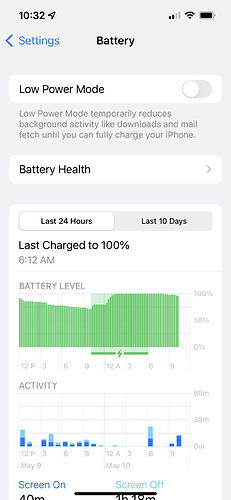Originally published at: How Apple Works Around Battery Chemistry Limits with Fast Charge and Optimized Battery Charging - TidBITS
Computer hardware engineers are clever, but even they can’t bypass the physical limitations of battery chemistry. Or can they? Apple has implemented some clever workarounds to maximize battery life and lifespan.
Sometimes I think my iPad or phone should be done charging but I’m stuck using with a pulling cord because charging slowed - now I know why.
I prefer to use the excellent utility FruitJuice in place of the regular battery menu. It tells me how long to use the Mac for each day unplugged, and having completed that, tells me to plug in.
Unfortunately, Fruit Juice is going into dormant state and will no longer be sold with support lasting only until year’s end:
I have been a Fruit Juice user for years, but I don’t think the developers were able to sync up its recommendations with Apple’s new battery management program. On my 2021 MacBook Pro, it always asked for a run of 1hr 50 minutes, no matter how much it had been used while not plugged in the previous day.
I’ve put Coconut Battery in my menu bar to be able to quickly check baterry stats.
Thanks Alan - I did not know that.
So with this optimization, can you leave your Mac, iPhone or iPad plugged in for extended periods of time?
Yes, that’s exactly the idea.
I have optimized battery charging turned on in my iPhone 13 Pro but I don’t feel like it’s working right. I’m ashamed to be so predictable, but I almost always go to bed at about 10 and at that time put my phone on a (non-Apple) wireless charger. I rarely ever use the phone at night, and take it off the charger at about 6am fully charged. But when I look at the Battery section in Settings, it shows that it charged rapidly to 100% by midnight or so, and then stayed at 100% all night. Is this going to give me reduced battery life as my 6 month old phone ages?
That looks like a classic battery optimization - the phone is initially charged and then held at a specific level for a while before it goes to 100%. I’m not sure why it starts charging so early in your case.
I just looked at mine for last night and it didn’t do optimized charging at all, but it usually does. My phone usually starts charging from 80% at about 4am; I’m usually getting out of bed somewhere between 6 am and 7 am.
When the iPhone is in optimized charging it will tell you (in my case on the lock screen) that it is holding off fully charging and by which time it expects to be fully charged. That of course is based on its assumption of when you will start using it again. In the case of @steve25 it looks like the iPhone for some reason assumes it needs to be ready by ~ 3 am. Would be interesting to see if that is indeed what it says.
Hmmm, I don’t believe I’ve ever noticed anything on the lock screen about optimized charging, or anything else especially about the charging. But again, my usual is just to place the phone on the charger as I’m going to bed for the night, so maybe there’s a message and I just never see it. When would such a message show up? When it first starts being charged, or after 10 minutes or something like that?
I’ve only seen a notification about optimized charging the first time the feature was used, which was about two weeks after I turned it on for my iPhone X and two weeks after I set up the 13 Pro. But, then again, I never look at my phone while I am in bed, so it’s possible there is a transient notification that disappears after the phone is fully charged and I unlock it the first time in the morning.
In my case the phone is plugged in and charging next to my bed. It usually aims to be fully charged by 4:30am because it has learned I get up around 6am. If I wake up around 2am, it will show 80% charged and display the message about optimized charging on its lock screen. It’s very similar in essence to what your Mac shows you under the battery menu when it’s hovering at ~80% due to OC.
